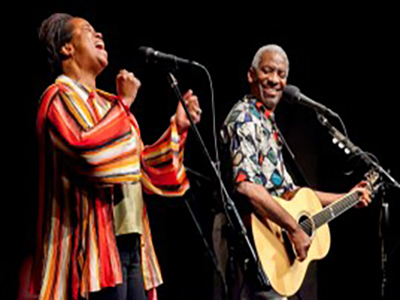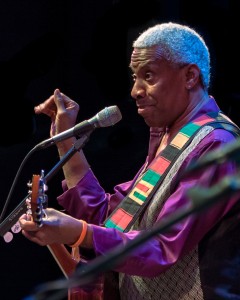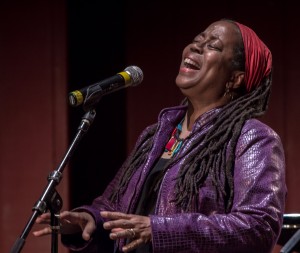
Where Music Makes a Difference
An Interview With Kim and Reggie Harris
by Stuart Stotts
I sat down virtually with Kim and Reggie Harris over the course of several weeks. During this time, Reggie was crisscrossing the country and Kim was in Ghana. Technology makes all things possible: by phone, Skype, e-mail, and text message, the powerful and uplifting story of these two musicians unfolded like a quilt made of song, story, community, justice, and hope.
Kim and Reggie have been singing together for over forty years. They’ve done thousands of school assemblies, hundreds of residencies, and perhaps as many teacher trainings. They focus on the power of song but in particular, they help to bring stories of the Underground Railroad and Civil Rights Movement to the eager ears of children and adults alike. That’s not all. Kim has a deep background in sacred music. One part of receiving her PhD was composing a Mass for Roman Catholic churches based on spirituals. Although they are both songwriters, lately Reggie has a greater focus on writing and performing songs for grownups, and his new CD, Ready to Go (soon to be available on the website here), is a testament to his skills and his soulful presence as a writer and performer.
Kim and Reggie have a wealth of wisdom, story, experience, and depth that goes on and on. I can share only part of what I was privileged to hear.
Stuart: So, let’s start with your own beginnings. What brought you to this life of music?

Reggie: I was raised in the church and anchored in a community of song, surrounded by song. And the messages that were transmitted were not narratives but were rather messages that said, “life will be difficult and song and community and connection will get you through.” That was the essence of what we sang in church.
Although I was raised in the church, I began to question the dogma. But I realized that there were some people who are certain ways most of the time and other people who are certain ways all of the time. And I wanted to be someone who you could depend on to be who I was, all of the time.
I also came out of camp counseling. I didn’t expect that singing with kids would be the biggest part of what I did for a while but it became that for many years.
Kim: I grew up singing many cautionary narratives in songs about “Letting the Ball Roll” and “Pins and Needles.” My childhood was surrounded by songs in Philly public schools and in my family and in Church.

The Presbyterian Church I grew up in was certainly less demonstrative in worship style than Reggie’s Baptist church. Although it was quieter and featured hymn singing of songs such as “Fairest Lord Jesus,” aka “Beautiful Savior,” a few spirituals did find their way into the weekly worship. “Let Us Break Bread Together on Our Knees.” It was in school, however, that I learned about the secret Underground Railroad codes in the songs. It was also there, through hearing and seeing assembly programs, that I caught the bug of wanting to make music and tell stories to young people.
How did you move into making music as your vocation?
Reggie: When we first started working together, there was an idea of entertainment first. Were we interesting enough to keep attention? Fairly early on, the key was that we were safe and engaging and had information about history and the world, in particular about interesting stories and singable songs. We were very aware that all these audiences out there had no idea about African American history and history in general and the struggle it has been.
From the days of bars and concerts, we began traveling the country and seeing how we were treated. First there was shock, and then there was anger. We started out touring across the nation, playing college campuses, ushered into a world at the end of the coffeehouse circuit. When we showed up, we were automatically different. People were nice enough. First year, we got a six-week tour. We were different and we were underpriced. Even at a campus with a thriving audience, the numbers would be down for us. And many people wouldn’t book us again, or they’d turn us over to the Black Student Union, thinking that they would want to use us. But with that recommendation by white people, there was no way that students of color, who were facing discrimination on campus and in town, would see us as an asset to their programming. Late 1970s and early ’80s, work was hard to come by, except in February (Black History Month.) It became apparent that we were being discriminated against, being African American in a society where that’s hard.
Song gives an outlet and a connection to the murdered and trafficked ancestors and helps to strengthen our resolve to work for abolition in our time and circumstances.
We didn’t get much work and wondered if we could make a living. Then we found out that the Philadelphia Folk Song Society had a program called the Odyssey of Folk Music. You could choose a topic where music made a difference in history and get booked for a week in schools. They were trying to build a future folk audience. We picked the Underground Railroad because of a small thing about code songs Kim remembered from fifth grade. It was 1982. We did a little research and put together a half-hour show, did five shows, and then began to offer that program to colleges too.
Kim: As we struggled to teach young people and to correct misrepresented narratives to more seasoned people, how could we represent these horrors? Song gives an outlet and a connection to the murdered and trafficked ancestors and helps to strengthen our resolve to work for abolition in our time and circumstances.
And during this current trip to Ghana at the Elmina and Cape Coast slave dungeons, certain songs came to mind. “Oh Lord How Come Me Here, I Wish I Never Been Born.” What else but cries, moans, screams, and finally songs (spirituals) in the “New World” could accompany the horrific journey of the ancestors?
Reggie: The program focused on codes and the agency of African-Americans in their own struggle for justice and freedom. The original myth was that it was kind white people helping poor black people. In fact, black people had a huge role in the Railroad. Our first recording was called Music on the Underground Railroad, and it contained the spirituals “Oh, Freedom” and “Wade in the Water.” It was a way into folk music societies that saw us as “too contemporary” or “not ethnic enough.” They weren’t going to let us do James Taylor and Cat Stephens or our fledgling original songs, so we found a niche. We were grateful to have a niche like that.
That opened up bookings at community centers and more schools, and we met an agent in ’86 who felt she could book us at institutions and concerts and festivals. Eighty percent of our work in the 1980s was around this topic.

Kim: Young people would ask, “Were you slaves? How do you know so much about all of this?” This of course makes us laugh. We don’t ask them if they think that we are 150 years old...they are quite likely to say YES!
Reggie: This led to a larger celebration of Black History, edging toward Civil Rights. Researching that show lit a fire about what we were willing to do. The stories were crushing—person after person overcoming struggle and hatred and lynching and murder and violence.
Kim: This eventually lead to our working with the Kennedy Center for the Performing Arts, offering workshops for teachers on the history and music of both the Underground Railroad and the modern Civil Rights Movement. And yes, though many things are written down and recoded digitally, it is STILL the oral transmission of traditions—live singing and storytelling—that captures the imagination.
How do two black people stand in front of mostly white audiences and talk about what black people have endured without paralyzing the audience?
Reggie: I have learned that, as folks like C. T. Vivian from SCLC would say, you realize you are working on something larger than yourself. And people are where they are and you have to meet them there, and hold them in your heart, with the possibility of transformation and get used to the fact that the likelihood that we would see the results was unlikely.
At all times, I need to present what I have with thoughtful compassion, including singing to audiences who reek of privilege. The real task is to approach the presentation of what I do with as much clarity and openness as I can muster. And I need to believe in the material itself. And always point with anything toward that sense of hope.
And how challenging are you willing to be with teachers and kids?
Reggie: In a program today, I talked about how the Birmingham Children’s Crusade used kids as part of the civil rights movement. That led to a discussion of the Parkland, Florida, students. This was with third graders.
At the end of a show about the Underground Railroad I will say, ‘You should know that people are still in slavery right now all around the world including here in America. You can look it up, so the work isn’t over.’
It’s important to know what has already been discussed with kids, know their context. We talked about what made it possible for those kids to step up in the Birmingham Children’s Crusade and what it would take today. I want to make kids and adults aware. I will take on lynching and I will take on gun violence.
I see my gift as being relational and empowering, not about telling people what to do. At the end of a show about the Underground Railroad, I will say, ”You should know that people are still in slavery right now all around the world including here in America. You can look it up, so the work isn’t over.”
There’s also power in story versus slogan. Let the story do the work, but don’t be afraid to let it hang there. In any given show, the hint of slogan shuts people down. Even in a historical show, the anthems are actually distancing. One of the hallmarks of the work we’ve done over the years is the stories that we tell. The way we tell the story is as important as what the story itself is.
Kim: Now that I am a college professor, I still remember this, even as I struggle to help young people to understand and appreciate how these traditions work, by connecting and engaging and transmitting the history, culture, and tradition of peoples. There are times when I will say, “Story time,” and simply sing to them and tell stories. Then of course there is a quiz on the material and how it connects to the time period we are studying. They may not remember that material, but I know they will remember the stories and walk down the hallowed halls of academia, humming “Wade in the Water.”
Reggie: Today for the wrap up, I needed to say something to give them a sense of the weight of it all. I asked for two things they remembered from the story. The answers came back: Kids don’t have to wait until they grow up. People need to try to get along, and even though you may not feel that these people are your brothers and sisters, you still need to treat them well.
The music [students] hear in childhood may be some of the best, most engaging, and most positive music they hear in their lives.
I want kids to realize they are important, that they matter. And I want them to realize that they can do something. They are not powerless to find something to do. Small things change the world.
Kim: These days, I am a professor at Loyola Marymount University in Los Angeles. I teach “In Search of a Way” and “African-American Religious Experience.” I continue to use music in my teaching. Many of the younger students enjoy and take part. By the time they get to third and fourth year, many students just sit there. They’d rather talk about singing than participate. And fun is right out of the question, even if the fun has to do with the subject matter and the students will be tested on it. That scenario feels sad to me, but I will keep going and there will be music. When I teach about rituals and use family and childhood memories to elucidate the ritual process, many of their best and most clear memories and learnings are surrounded by and steeped in music. Except for the songs on the radio, streamed, and on commercials, the music they hear in childhood may be some of the best, most engaging, and most positive music their hear in their lives. Believe it or not, “You Are My Sunshine” is a real favorite. That surprised me!
Speaking of surprises, I am writing and speaking this over a very long distance phone and broadband line, from Ghana, West Africa. The music and dance permeates the life and spirituality of the people, in their many different ways of expressing spirituality.
What stood out for me yesterday, however, was a song I sang in childhood.
It was “Never Smile at a Crocodile,” from Disney's Peter Pan—“No, you can’t get friendly with a crocodile / Don’t be taken in by his welcome grin / He’s imagining how well you’d fit within his skin.”
After a tour of the rainforest and a canopy walk about thirty meters above the forest Kakum National Park, the LMU Study Abroad students and faculty ate lunch nearby. In the pond at the restaurant were crocodiles. Yes, I went with the small group to see one up close; yes, I got to VERY CAREFULLY touch the back of this prehistoric reptile. Amazing, awesome, sacred. And music came to mind. There I was in Ghana humming “Never Smile at a Crocodile” and realizing the wisdom of the song. WHEW!
(Never thought I’d actually have to be reminded about crocodiles!)
Reggie: I sang that song too! Never forgot the message.
Kim: What I want to say to CMN members is: Please keep doing your work, writing your songs, teaching your musical traditions and engaging with young people!
Reggie: Thank you all for honoring us with this marvelous award. We are so grateful for your recognition and support for the work we have been doing for all these years. As you know, it’s both a challenge and a gift. But the love and concern that drives the mission also renews the heart and mind in times like these. We are all partners in the joy and in the struggle. I feel so energized by the energy of this musical family. We are needed now, more than ever.